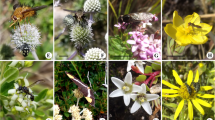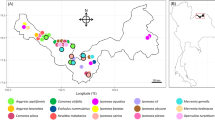Abstract
THE development of a predictive theory of pollinator–plant coevolution requires a means of assessing and comparing quantitatively the costs and benefits of different pollinator foraging strategies and plant flowering strategies. Although there are quantitative data for pollinator strategies1–3, the relative benefits to the plant of alternative pollinators, in terms of pollen transferred, ovules fertilised, and seeds set, have never been quantified for field conditions. Likewise, reference to the most effective pollinator4 of a plant species is often based on estimates of the abundance of alternative pollinators. Demonstrations that various pollinators can cause seed set in caged plants5 and that pollinators transfer pollen in different amounts6,7 are difficult to relate to natural conditions. We have developed a quantitative approach for comparing the relative importance of alternative pollinators in terms of the quantity, level of out-crossing and efficiency of pollen transferred. We have used this approach to investigate the pollination of evening primroses, Oenothera fruticosa L. (Onagraceae), by two principal pollinators, European honey bees, Apis mellifera L., and soldier beetles, Chauliognathus marginatus Fab.
Similar content being viewed by others
References
Heinrich, B., and Raven, P. H., Science, 176, 597–602 (1972).
Linhart, Y. B., Am. Nat., 107, 511–523 (1973).
Hainsworth, F. R., J. comp. Physiol., 88, 425–431 (1974).
Stebbins, G. L., Flowering Plants (Harvard University Press, Cambridge, 1974).
Alcorn, S. M., McGregor, S. E., and Olin, G., Science, 133, 1594–1595 (1961).
Levin, D. A., and Berube, D. E., Evolution, 26, 242–250 (1972).
Kislev, M. E., Kraviz, Z., and Lorch, J., Israel J. Bot., 21, 57–75 (1972).
Beattie, A. J., Breedlove, D. E., and Ehrlich, P. R., Ecology, 54, 81–91 (1973).
Mulcahy, D. L., and Caporello, D., Am. J. Bot., 57, 1027–1030 (1970).
Pederson, M. W., Bot. Gaz., 115, 129–138 (1953).
Janzen, D. H., Science, 171, 203–205 (1971).
Author information
Authors and Affiliations
Rights and permissions
About this article
Cite this article
PRIMACK, R., SILANDER, J. Measuring the relative importance of different pollinators to plants. Nature 255, 143–144 (1975). https://doi.org/10.1038/255143a0
Received:
Accepted:
Issue Date:
DOI: https://doi.org/10.1038/255143a0
- Springer Nature Limited
This article is cited by
-
Pollen grain morphology is not exclusively responsible for pollen collectability in bumble bees
Scientific Reports (2019)
-
Identifying population thresholds for flowering plant reproductive success: the marsh gentian (Gentiana pneumonanthe) as a flagship species of humid meadows and heathland
Biodiversity and Conservation (2018)
-
Insights from measuring pollen deposition: quantifying the pre-eminence of bees as flower visitors and effective pollinators
Arthropod-Plant Interactions (2017)
-
Floral neighborhood influences pollinator assemblages and effective pollination in a native plant
Oecologia (2014)
-
Poor correlation between the removal or deposition of pollen grains and frequency of pollinator contact with sex organs
Naturwissenschaften (2013)





